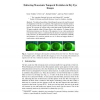Free Online Productivity Tools
i2Speak
i2Symbol
i2OCR
iTex2Img
iWeb2Print
iWeb2Shot
i2Type
iPdf2Split
iPdf2Merge
i2Bopomofo
i2Arabic
i2Style
i2Image
i2PDF
iLatex2Rtf
Sci2ools
MICCAI
2009
Springer
2009
Springer
Enforcing Monotonic Temporal Evolution in Dry Eye Images
We address the problem of identifying dry areas in the tear film as part of a diagnostic tool for dry-eye syndrome. The requirement is to identify and measure the growth of the dry regions to provide a time-evolving map of degrees of dryness. We segment dry regions using a multi-label graph-cut algorithm on the 3D spatio-temporal volume of frames from a video sequence. To capture the fact that dryness increases over the time of the sequence, we use a time-asymmetric cost function that enforces a constraint that the dryness of each pixel monotonically increases. We demonstrate how this increases our estimation's reliability and robustness. We tested the method on a set of videos and suggest further research using a similar approach.
| Added | 06 Nov 2009 |
| Updated | 08 Dec 2009 |
| Type | Conference |
| Year | 2009 |
| Where | MICCAI |
| Authors | Tamir Yedidya, Peter Carr, Richard Hartley, Jean-Pierre Guillon |
Comments (0)

